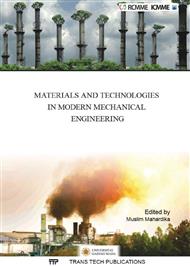p.19
p.24
p.31
p.36
p.43
p.53
p.61
p.67
p.74
Vickers Microhardness Dependence Load and Determining of Tensile Strength of HQ 705 Steel from Microhardness Curves
Abstract:
Vickers microindentation hardness test has been applied for a long time to determine the mechanical properties of a small volume of samples. The procedure of this hardness test consists of using a constant load on a rigid indenter and measuring the dimensions of the indenter residual impression (indentation imprint) on the surface of the sample tested after loading and unloading. The objective of this research is to characterize the mechanical properties and material constants of HQ (High Quality) 705 alloy steel mainly its VHN (Vickers Hardness Number) and tensile strength before and after quenching and tempering heat treatments. The characterization is based on Vickers microhardness dependence load curves.Quenching treatment was performed in a furnace by heating the samples at austenite temperature of 850 o C with holding time of two hours and then the samples were rapidly cooled in oil bath. Tempering processes were conducted by heating again the quenching samples to temperatures of 150, 200, 250, 300, 350, 400, 450, 500, 550 and 600 o C with holding time of two hours for each sample. Finally, all samples were slowly cooled in atmospheric temperature. The mechanical properties of samples were characterized by using Vickers microhardness dependence load curves.The results show that VHN (Vickers Hardness Number) depends on indentation load and VHN increases with increment of load for indentation load lower than 5 N. VHN is almost constant for indentation load greater than 5 N. The raw material (without heat treatment) has the VHN and tensile strength of 3413 MPa and 1050.61 MPa respectively and the quenched samples have the VHN and tensile strength of 5407 and 1861 MPa respectively. The Vickers hardness and tensile strength decrease with the increment of tempering temperatures. The higher tempering temperature produces lower hardness and tensile strength. The raw material tensile strength of 1058.8 MPa obtained by tensile test is comparable to its tensile strength of 1050.61 MPa obtained by Vickers indentation. This result indicates that Vickers microindentation is valid to use for evaluating the tensile strength of HQ 705 alloy steel.
Info:
Periodical:
Pages:
43-52
Citation:
Online since:
June 2016
Authors:
Keywords:
Price:
Сopyright:
© 2016 Trans Tech Publications Ltd. All Rights Reserved
Share:
Citation:


